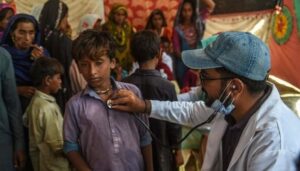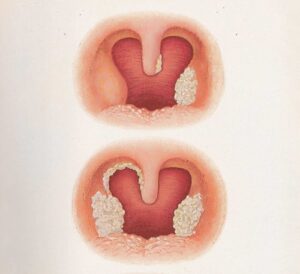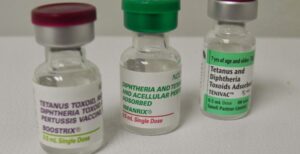
Introduction
Diphtheria is a serious infection caused by bacteria called Corynebacterium diphtheria. Currently, Pakistan is experiencing an outbreak of diphtheria and not many people are aware of it. However, this seemingly new disease is not new and newborns are given a vaccine to prevent this infection. This lowered the disease prevalence in the last few years which is why not many people are aware of it now. Unfortunately, diphtheria infection is back in Pakistan, and to unveil the reason, more research is required.
The following blog will educate you about a Diphtheria infection, what are its symptoms, treatment, recovery, and prevention.
What is Diphtheria?
As stated above, Diphtheria is a bacterial infection that is caused by the specie called Corynebacterium Diphtheriae (C. diphtheriae) also known as Orynebacterium Ulcerans (C. ulcerans). The bacteria spread from one person to another by droplets of moisture coughed and sneezed into the air by the disease carrier. These bacteria then enter the mouth or respiratory airways of healthy individuals where it multiplies to make them sick. It can also spread from shared utensils, wounds, clothing, hygiene items, and bedding. Since Diphtheria infection spreads fast, it requires extra caution and care.
The outbreak of diphtheria in Pakistan
Pakistan is currently facing an outbreak of diphtheria. With an unfortunate total of 45 fatalities of children and teenagers to this disease in 2022 in Pakistan, NIH has issued an advisory about the outbreak and has warned people and officials to stay alert to manage any harsh situations. These are the numbers that were reported, and thus another sum of cases can be suspected in the areas of Sindh, KPK, Azad Kashmir, Punjab, Baluchistan, and Gilgit-Baltistan. Owing to the weather and general customs, the months of November to February are the most critical to manage the diphtheria outbreak as the cases increase significantly in these months.
Diphtheria vaccines had been around for many decades which has helped in the elimination of this disease in many countries. However, Pakistan is still struggling. The Ministry of National Health Services, Regulations and Coordination (NHS, R&C) is blaming the bad quality of vaccinations for this outbreak of diphtheria.

Symptoms of Diphtheria
There are two ways in which diphtheria surfaces itself, it is either in the respiratory airways or on the skin. Skin-related symptoms are usually a result of poor hygiene. The symptoms usually appear in 2 to 5 days after the bacteria invade the body and it is commonly diagnosed by PCR test. Common respiratory symptoms include;
- High fever
- Sore throat
- Painful swallowing
- Difficulty in breathing
- Swollen neck glands
- Grey-white layering in the throat
Diphtheria which surfaces on the skin is called cutaneous diphtheria, its common symptoms are;
- Sore skin
- Puss-filled blisters
- Large ulcers on the skin
Immediate isolation is recommended for patients diagnosed with diphtheria owing to its high contagiousness.

Treatment of Diphtheria
Since Diphtheria infection is caused by a bacterium, an antitoxin is used to stop its toxins to cease the adverse actions. The antitoxin treatment is usually used for the treatment of respiratory diphtheria. Antibiotics are also used against the bacteria causing diphtheria. Antibiotic treatment can be used to treat all types of diphtheria by acting on the bacteria of the eyes, blood, skin, and respiratory airways.
Antibiotics also help in stopping the transmission of the infection from the diseased to normal people within 48 hours of use. However, like any other antibiotics, it is recommended to complete the course to fully eliminate the disease. After the completion of the antibiotic course, the patient is again tested to ensure that the treatment was successful and bacterial strands no longer exist in the body.
If you are experiencing the above-stated symptoms of diphtheria then consult immediately with a trusted doctor to ensure timely treatment. With Sehat Kahani, you can not only consult but can also book diagnostic tests through which you can get your samples collected from home in just a few clicks.
Recovery from Diphtheria
Along with medication, recovering from diphtheria requires a lot of bed rest. Care during recovery also depends on which parts of the body were affected by the disease. Heavy physical activity should be avoided during recovery and the patients should opt for a liquid diet to get the nutrition without exacerbating the throat pain.
During recovery, strict isolation is required as diphtheria is a very contagious disease. Other SOPs including disinfection of shared surfaces and regular hand washing should also be practiced to eliminate the chances of cross-contamination. Caretakers and family members are especially vulnerable and thus should take extra care of their hygiene.
Diphtheria is one of the infections having the possibility to reoccur multiple times in life. Thus after the completion of treatment, a complete course of vaccination for diphtheria is recommended to prevent the reoccurrence of the disease.
Ways you can prevent Diphtheria
The most assured way to prevent diphtheria is vaccination. There are multiple vaccinations made to protect against diphtheria along with other diseases. Td and DT help in protection against tetanus and diphtheria whereas DTaP and Tdap protect against diphtheria, tetanus, and pertussis. The administration of different types of vaccination depends on the age of the individual. Td or Tdap is recommended for adults and is administered every 10 years whereas preteens are administered with Tdap and young children can benefit from DTap.

According to the statistics, diphtheria medication is proven to be safe for most people and no serious problem has been reported. However, mild side effects may surface. Ideally, these side effects should not hinder everyday activities and if so then medical attention should be taken immediately.
People in close contact with someone having diphtheria should take extra preventive measures. CDC recommends that these individuals should get prophylaxis, meaning they should be administered some doses of antibiotics to prevent them from catching diphtheria. Along with these drugs, they should be monitored at regular intervals for 7 to 10 days for possible infection after their last exposure. Test samples are taken in the form of swabs from the throat and nose which are then cultured to check the presence of diphtheria colonies.




